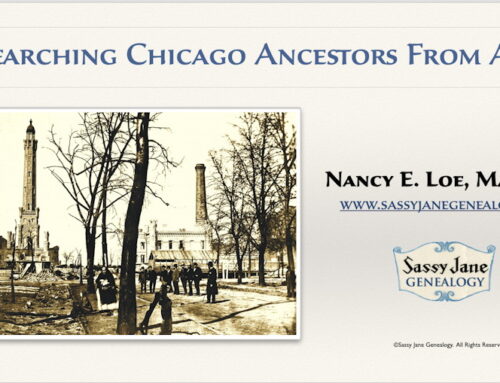The Western State Lunatic Asylum and Martha Saul is my follow-up post to a 2010 Madness Monday post about my husband’s great-great grandmother. In 1860, she was a wife and mother to five children; in the 1870 census, she was found at the “Western State Lunatic Asylum” in Staunton, Virginia. Read my original post here.
It’s only taken seven years, but I know more now about what happened to Martha Saul. I took this up again with some trepidation, as 19th- and 20th-century horror stories abound about warehousing incompatible wives and bothersome mothers. I’ll never know Martha’s true story, but I do have some facts. Martha’s husband died some time in 1863. And she was committed to the Western State Lunatic Asylum on 15 Sep 1864. She lived there for 27 years, 3 months, 11 days, all the time left to her, before dying on Christmas Day, 1891, of heart disease.
About the Western State Lunatic Asylum
In January 1825 the Virginia General Assembly passed legislation providing for the construction of an asylum in the western part of the state. A Court of Directors was commissioned by the Governor to serve as the asylum’s governing body and charged with purchasing a site close to the town of Staunton, west of the Blue Ridge Mountains, on which to build an asylum to house the mentally ill of western Virginia. The institution, which became known as Western Lunatic Asylum, was the second mental health facility built in the Commonwealth of Virginia. The buildings and surrounding gardens were designed to embrace the idea of “moral therapy” for mentally ill patients by providing an aesthetically pleasing and tranquil atmosphere in which patients lived comfortably, exercised and worked outdoors.
Western Lunatic Asylum opened in 1828, accepting both male and female patients suffering from a variety of mental disorders. Common diagnoses included “hard study,” “religious excitement,” and “debility of the nervous system.” The asylum was overseen by a Keeper, a Matron and a visiting physician during its earliest years. The hospital also employed attendants, gate keepers, night watch personnel, farm hands, and a steward who handled the day-to-day financial operations. The first superintendent appointed to oversee Western Lunatic Asylum was Dr. Francis T. Stribling. Dr. Stribling was a proponent of the moral therapy approach, and was a leader in the early mental health community. Dr. Stribling was one of the thirteen founders of the Association of Medical Superintendents of American Institutions for the Insane, which later became known as the American Psychiatric Association. Dr. Stribling served as the hospital superintendent and as a physician until his death in 1874.
Tom Kirsch, a blogger at Opacity, continues the story of the hospital:
…After the Civil War, the moral therapy approach and the asylum model of care was proving to be a failure. Western State and most other asylums in America were becoming warehouses for the outcasts of society, and the architecture of the buildings (while beautiful), proved to be unsafe and more of a hindrance. More extreme methods of treatment were taking place at WSH and other hospitals, which involved restraint, seclusion, and eventually prefrontal lobotomies, seizure induction, and sterilization.
In 1905 a renowned physician named Dr. Joseph DeJarnette would become superintendent of WSH, and kept this position for 38 years, the longest tenure ever in the hospital’s history. His views strongly embraced the eugenics movement, and many patients were involuntary sterilized at Western State in an attempt to improve the genetic quality of the human population. The doctor also opened and operated a private sanitarium close to the state hospitals grounds called the DeJarnette Sanitarium, named in his honor.
In 1883, the hospital was the site of unsolved murders of patients via poisoning. THE ASYLUM POISONINGS: DEATH, POLITICS, AND “LOW CUSSEDNESS” IN STAUNTON provides disturbing details: “….the morning of 24 February 1883, just after receiving their regular liquid medications, seven male patients lost consciousness. Four died almost immediately, two died in the next three days, and one recovered.”
After World War II, the hospital went through several incarnations and a peak population of 3,000. Today the last facility on the site has been renovated into a condominium complex called Villages at Staunton. The irony, it is rich. The sketch at the top of this post dates to about 1891 and is courtesy of Virginia Memory.
Records of Martha Saul

Martha Saul’s entry in the Admission Register, p. 3
1. Western State Lunatic Asylum Records
Finding Western State Lunatic Asylum surviving records was surprisingly easy, thanks to the complete finding aid to the records at The Library of Virginia. These can be tricky records to process and allow access to for privacy reasons, so my hat is off to my archivist colleagues there.
“The patient-related records include admission registers, commitment papers, medical records, and several types of patient lists,” according to the finding aid.
And that’s where these unusual records paid off with information about Martha Saul’s admission and diagnosis of “dementia,” as well as her death date (see one page of the ledger at left).
2. 1880 U.S. Federal Census Schedules of Defective, Dependent, and Delinquent Classes

Martha Saul’s entry in the “U.S. Federal Census Schedules of Defective, Dependent, and Delinquent Classes,” 1880
Other unusual records not available when I first started searching for Martha Sual include this appallingly named 1880 federal census schedule. Here’s how the Census Bureau defined those they placed on this schedule:
This schedule included different forms to enumerate the following classes of individuals:
- Insane
- Idiots
- Deaf-mutes
- Blind
- Paupers and Indigent persons
- Homeless children
- Prisoners





Martha Saul was my 3rd Great Grandmother. I appreciate the information you have posted here.
Thx, Sheri. It is a very sad story.
I too have found a person I am doing genealogical research on, who shows up on the 1880 “defective” census at SWH – he was there until 1918 where he ultimately died of TB. I have just begun the search for records. Thank you for this work.
Glad it helps, Cathy. Let us know what you find.